Moreno Valley, California, Hgh State Clinic, Hgh Injections, Hrt Doctors
Moreno Valley, California Blood Testing Facilities
 Represents a LabCorp blood testing facility
Represents a LabCorp blood testing facility Represents a Quest Diagnostics blood testing facility
Represents a Quest Diagnostics blood testing facility

Nearby Labcorp Blood Testing facilities:
- Labcorp Center Distance: 0 m, 12712 Heacock St. Ste 7, Moreno Valley, Riverside County, CA, 92553
- Labcorp Center Distance: 6 m, 255 Terracina Blvd Ste 106, Redlands, San Bernardino County, CA, 92373
- Labcorp Center Distance: 9 m, 6927 Brockton Ave Ste 1B, Riverside, Riverside County, CA, 92506
- Labcorp Center Distance: 12 m, 34845 Yucaipa Bl. Ste B, Yucaipa, San Bernardino County, CA, 92399
- Labcorp Center Distance: 13 m, 399 E. Highland Ave. Ste 510, San Bernardino, San Bernardino County, CA, 92404
- Labcorp Center Distance: 14 m, 10420 Beaumont Ave. Suite G, Cherry Valley, Riverside County, CA, 92223
- Labcorp Center Distance: 17 m, 29798 Haun Rd Ste 102, Menifee, Riverside County, CA, 92586
- Labcorp Center Distance: 19 m, 31571 Canyon Estates Dr Ste101, Lake Elsinore, Riverside County, CA, 92532
- Labcorp Center Distance: 20 m, 850 E. Latham Ave. Ste Cd, Hemet, Riverside County, CA, 92544
- Labcorp Center Distance: 22 m, 10801 Foothill Blvd Ste 105, Rancho Cucamonga, San Bernardino County, CA, 91730
- Labcorp Center Distance: 24 m, 36320 Inland Valley Dr Ste 103, Wildomar, Riverside County, CA, 92595
- Labcorp Center Distance: 25 m, 1310 San Bernardino Rd Ste 107, Upland, San Bernardino County, CA, 91786
- Labcorp Center Distance: 26 m, 12555 Central Ave. Ste Af, Chino, San Bernardino County, CA, 91710
- Labcorp Center Distance: 29 m, 27699 Jefferson Ave Ste 209, Temecula, Riverside County, CA, 92590
- Labcorp Center Distance: 30 m, 29873 Santa Margarita Pkwy102, Rancho Santa Margarita, Orange County, CA, 92688
- Labcorp Center Distance: 32 m, 31150 Temecula Parkway Ste 201, Temecula, Riverside County, CA, 92592
- Labcorp Center Distance: 33 m, 17450 Main St. Suite C, Hesperia, San Bernardino County, CA, 92345
- Labcorp Center Distance: 35 m, 1201 N. Rose Dr. Suite 202, Placentia, Orange County, CA, 92870
- Labcorp Center Distance: 36 m, 12332 Hesperia Rd Suite B, Victorville, San Bernardino County, CA, 92395
- Labcorp Center Distance: 37 m, 12677 Hesperia Rd. Suite 170A, Victorville, San Bernardino County, CA, 92395
- Labcorp Center Distance: 38 m, 587 E. Elder Street, Fallbrook, San Diego County, CA, 92028
- Labcorp Center Distance: 39 m, 1100 N Palm Canyon Dr Ste 207, Palm Springs, Riverside County, CA, 92262
- Labcorp Center Distance: 40 m, 555 E. Tachevah Dr. Suite 3E, Palm Springs, Riverside County, CA, 92262
- Labcorp Center Distance: 41 m, 16008 Kamana Dr. Suite 201, Apple Valley, San Bernardino County, CA, 92307
- Labcorp Center Distance: 42 m, 7872 Walker St. Suite 109, La Palma, Orange County, CA, 92801
- Labcorp Center Distance: 43 m, 400 Newport Center Dr Ste 202, Newport Beach, Orange County, CA, 92660
- Labcorp Center Distance: 44 m, 15064 Moran Street, Westminster, Orange County, CA, 92683
- Labcorp Center Distance: 45 m, 1501 Superior Ave. Ste 209, Newport Beach, Orange County, CA, 92663
- Labcorp Center Distance: 46 m, 17822 Beach Bl Suite 242, Huntington Beach, Orange County, CA, 92647
- Labcorp Center Distance: 47 m, 18821 Delaware St. Ste 102, Huntington Beach, Orange County, CA, 92648
- Labcorp Center Distance: 48 m, 57725 29 Palms Hwy Ste 110, Yucca Valley, San Bernardino County, CA, 92284
- Labcorp Center Distance: 49 m, 72780 Country Club Drive 303C, Rancho Mirage, Riverside County, CA, 92270
- Labcorp Center Distance: 50 m, 73345 Highway 111 Suite 204B, Palm Desert, Riverside County, CA, 92260
- Labcorp Center Distance: 51 m, 1190 Pacific Coast Hwy Ste C, Seal Beach, Orange County, CA, 90740
- Labcorp Center Distance: 52 m, 2067 West Vista Way Suite 275, Vista, San Diego County, CA, 92083
- Labcorp Center Distance: 53 m, 960 E Green St Suite 290, Pasadena, Los Angeles County, CA, 91106
- Labcorp Center Distance: 54 m, 41120 Washington St Ste 105, Bermuda Dunes, Riverside County, CA, 92203
- Labcorp Center Distance: 55 m, 1595 Grand Ave Ste 109, San Marcos, San Diego County, CA, 92078
- Labcorp Center Distance: 56 m, 79200 Corporate Ctr Dr.Ste 204, La Quinta, Riverside County, CA, 92253
- Labcorp Center Distance: 57 m, 1955 Citracado Pkwy Suite 103, Escondido, San Diego County, CA, 92029
- Labcorp Center Distance: 58 m, 81557 Dr. Carreon Blv. Ste A3, Indio, Riverside County, CA, 92201
- Labcorp Center Distance: 59 m, 1400 S Grand Ave Ste 612, Los Angeles, Los Angeles County, CA, 90015
- Labcorp Center Distance: 60 m, 1510 S Central Ave. Ste 520, Glendale, Los Angeles County, CA, 91204
- Labcorp Center Distance: 61 m, 345 Saxony Rd Ste 201B, Encinitas, San Diego County, CA, 92024
- Labcorp Center Distance: 62 m, 351 Santa Fe Dr Ste 210, Encinitas, San Diego County, CA, 92024
- Labcorp Center Distance: 63 m, 1360 W 6Th St Ste 190, San Pedro, Los Angeles County, CA, 90732
- Labcorp Center Distance: 64 m, 3500 Lomita Blvd. Suite 102, Torrance, Los Angeles County, CA, 90505
- Labcorp Center Distance: 65 m, 15721F Bernardo Heights Pkwy, San Diego, San Diego County, CA, 92128
- Labcorp Center Distance: 66 m, 574 E. Virginia Way, Barstow, San Bernardino County, CA, 92311
- Labcorp Center Distance: 67 m, 3831 Hughes Ave. Ste 607, Culver City, Los Angeles County, CA, 90232
- Labcorp Center Distance: 68 m, 627 West Ave Q Suite B, Palmdale, Los Angeles County, CA, 93551
Nearby Quest Blood Testing facilities:
- Quest Center Distance: 2 m, 6485 Day St, Riverside, Riverside County, CA, 92507-0926
- Quest Center Distance: 9 m, 4646 Brockton Ave, Riverside, Riverside County, CA, 92506-0103
- Quest Center Distance: 12 m, 9041 Magnolia Ave, Riverside, Riverside County, CA, 92503-3956
- Quest Center Distance: 13 m, 2150 N Waterman Ave, San Bernardino, San Bernardino County, CA, 92404-4811
- Quest Center Distance: 19 m, 118 W 9Th St, Corona, Riverside County, CA, 92882-3320
- Quest Center Distance: 20 m, 32251 Mission Trl, Lake Elsinore, Riverside County, CA, 92530-4536
- Quest Center Distance: 25 m, 1399 E Foothill Blvd, Upland, San Bernardino County, CA, 91786-4060
- Quest Center Distance: 28 m, 4028 Grand Ave, Chino, San Bernardino County, CA, 91710-5486
- Quest Center Distance: 29 m, 27699 Jefferson Ave, Temecula, Riverside County, CA, 92590-2696
- Quest Center Distance: 35 m, 23521 Paseo De Valencia, Laguna Hills, Orange County, CA, 92653-3673
- Quest Center Distance: 37 m, 12370 Hesperia Rd, Victorville, San Bernardino County, CA, 92395-4787
- Quest Center Distance: 38 m, 1310 W Stewart Dr, Orange, Orange County, CA, 92868-3838
- Quest Center Distance: 40 m, 555 E Tachevah Dr, Palm Springs, Riverside County, CA, 92262-5750
- Quest Center Distance: 43 m, 11180 E Warner Ave, Fountain Valley, Orange County, CA, 92708-7515
- Quest Center Distance: 44 m, 9900 Talbert Ave, Fountain Valley, Orange County, CA, 92708-5153
- Quest Center Distance: 47 m, 18800 Main St, Huntington Beach, Orange County, CA, 92648-1718
- Quest Center Distance: 48 m, 57370 29 Palms Hwy, Yucca Valley, San Bernardino County, CA, 92284-2900
- Quest Center Distance: 51 m, 416 W Lastunas Dr, San Gabriel, Los Angeles County, CA, 91776-1236
- Quest Center Distance: 52 m, 3601 Vista Way, Oceanside, San Diego County, CA, 92056-4559
- Quest Center Distance: 53 m, 960 E. Green St., Pasadena, Los Angeles County, CA, 91106-2405
- Quest Center Distance: 58 m, 420 E 3Rd St, Los Angeles, Los Angeles County, CA, 90013-1646
- Quest Center Distance: 59 m, 81715 Dr Carreon Blvd, Indio, Riverside County, CA, 92201-5564
- Quest Center Distance: 61 m, 477 N El Camino Real, Encinitas, San Diego County, CA, 92024-1353
- Quest Center Distance: 63 m, 1294 W 6Th St, San Pedro, Los Angeles County, CA, 90731-2998
- Quest Center Distance: 64 m, 23441 Madison St, Torrance, Los Angeles County, CA, 90505-4735
- Quest Center Distance: 66 m, 309 E Mountain View St, Barstow, San Bernardino County, CA, 92311-2814
- Quest Center Distance: 76 m, 18250 Roscoe Blvd, Northridge, Los Angeles County, CA, 91325-4265
- Quest Center Distance: 77 m, 18350 Roscoe Blvd, Northridge, Los Angeles County, CA, 91325-5607
- Quest Center Distance: 81 m, 5103 Garfield St, La Mesa, San Diego County, CA, 91941-5103
- Quest Center Distance: 89 m, 2876 Sycamore Dr, Simi Valley, Ventura County, CA, 93065-1550
- Quest Center Distance: 90 m, 480 4Th Ave, Chula Vista, San Diego County, CA, 91910-4411
- Quest Center Distance: 92 m, 1220 La Venta Dr., Westlake Village, Ventura County, CA, 91361-3749
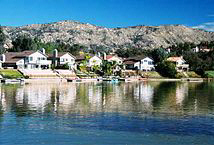
Moreno Valley California Hormone Replacement Therapy Services
Have you ever considered Hormone Optimization? Hormone Balance is one of the keys to maintaining peak health and wellness at any age, and our Licensed and Board Certified Moreno Valley Hormone Clinic specializes in HRT Treatments designed to help improve your life and uplift your vitality. We offer a range of services, including HGH Therapy, Testosterone Replacement, Sermorelin Acetate Injections, and HCG Therapy, all designed to help you reach a state of improved physiological harmony.
We offer our quality Moreno Valley HRT Services to patients thirty years of age and older. Hormone Imbalance becomes both more common and more problematic with age. If you feel that Hormone Replacement Therapy could benefit you as a patient, our quality Hormone Doctors are just a phone call away. Also, feel free to fill out the form on this page!
Finding a Hormone Doctor in Moreno Valley California
With the help of our Board-Certified Hormone Clinic, it's easier than ever to get tested for Hormone Imbalance and Deficiency. After you agree to hormone evaluation, we will set up an appointment with a doctor in the Moreno Valley Area that will work with us to provide a preliminary health screening, which includes both a routine physical and blood drawing. Your blood sample is the key to unlocking the secrets of your Health and Hormone State.
We will run a Comprehensive Hormone and Metabolic Panel which will thoroughly evaluate various Hormone Levels including Human Growth Hormone, Thyroid Hormone, IGF-1, Free Testosterone, Total Testosterone, and more. After we receive the results of your testing, we will work with you to design a Hormone Plan suitable to meet your needs as a patient.
Low-T Treatments for Testosterone Deficiency in Moreno Valley
One of the most Popular Hormone Treatments that we offer at our Moreno Hormone Clinic is Testosterone Replacement Therapy. Low-T is a condition that impacts the lives of hundreds of millions of men across the United States and hundreds of thousands of men in Southern California. If you've noticed a distinct drop in sexual desire, satisfaction, and/or ability as you grow older, you may be an ideal candidate for our Testosterone Replacement Services. Testosterone also may be able to increase your energy, boost muscle mass, increase your confidence, and more. We offer a variety of Testosterone Products, including Testosterone Creams, Low-T Gels, and Testosterone Injections, all of which are safe and effective at restoring your Testosterone Levels to baseline!
HGH Injection Therapy in Moreno Valley California
Another service that we provide to Hormone Deficiency Patients in Moreno Valley is Human Growth Hormone Therapy. HGH Deficiency is far more common than most people realize. HGH Levels plateau during the late teens and twenties, then begin a long, slow descent over the rest of your life. The period which HGH Deficiency becomes symptomatic is sometimes referred to as Somatopause. HGH Deficiency commonly becomes problematic in a person's forties or fifties, depending on a number of factors, including activity level, weight, genetics, and more.
Growth Hormone Deficiency is characterized by a number of symptoms, including lack of energy, depression, loss of muscle mass, weight gain, mild cognitive decline, trouble healing, slow recovery from illness, and more. Luckily, Human Growth Hormone Therapy is highly effective at treating the symptoms of Somatopause, improving your quality of life and helping you live the life you want to live as you enter your golden years. HGH Therapy is given via daily subcutaneous injection, and there are a number of products available that make Prescription Growth Hormone simple and easy to administer!
Moreno Valley Sermorelin HGH Alternative Treatments
In addition to Prescription HGH, we also offer a cutting-edge Hormone Treatment to our patients known as Sermorelin Acetate Therapy. Both Human Growth Hormone and Sermorelin have the ability to restore HGH Levels to a healthy baseline for patients suffering from Age-Related Growth Hormone Deficiency in Moreno Valley. Whereas HGH Therapy replaces the body's waning Growth Hormone Production, Sermorelin stimulates the body's natural ability to produce Human Growth Hormone. Sermorelin is a secretagogue, meaning that its a precursor Hormone that stimulates the production of other, vitally important hormones.
Sermorelin is a cost-effective alternative to HGH that you may qualify for, even if you aren't approved for Growth Hormone Therapy. Sermorelin safely boosts HGH Production for aging men and women and is available for off-label prescription in California for those with moderate HGH Deficiency.
Prescription Hormone Therapy in Moreno Valley California
Though we place an emphasis on the treatment of Low-T and Age-Related HGH Deficiency, we can also help you restore Hormone Balance in other ways, and utilize Hormone Treatments to improve your health in other ways. For example, we offer HCG Therapy for Weight Loss for patients interested in losing weight fast. We also have Hormone Products available for other forms of Hormone Deficiency and Imbalance. If you live in the Los Angeles Metro area and are interested in working with a Licensed Moreno Valley Hormone Clinic, or simply have questions about the services that we provide, we encourage you to give us a call!
Information about Moreno Valley California
Moreno Valley is one of the largest cities in the Greater Los Angeles Metropolitan area. Perhaps surprisingly, it is also one of the newest communities in the area, only experiencing rapid population growth since the late 1970s and early 1980s. Moreno Valley also belongs to a region of California known as the Inland Empire, a highly populated region to the west of Los Angeles that is highly productive and fertile agriculturally.
The area is referred to as the Inland Empire because, as opposed to the many major coastal cities of California, this region represents the largest population of Californians that live off of the coast. Moreno Valley is located just to the south of San Bernadino, the largest city of the Inland Empire. Other cities that neighbor Moreno Valley are Woodcrest, Mead Valley, Lakeview, El Casco, and Riverside. Among the neighborhoods of Moreno Valley are Shadow Mountain, Rancho Belago, Hidden Springs, Moreno Valley Ranch, and Sunnymead Ranch.
Things to Do in Moreno Valley
Moreno Valley is situated perfectly for those that enjoy the outdoors. There are a number of parks and protected wilderness areas just beyond the border of Moreno Valley. Box Springs Mountain Reserve Park and Sycamore Canyon Wilderness Park are located to the west of Moreno Valley, and the most popular outdoor attraction is the Lake Perris State Recreation Area, which cradles the Perris Reservoir. For people that enjoy hunting, the Upland Game Hunting Area is located just to the north of the park, and is popular for bird hunting and small game hunting.
Moreno Valley is home to a number of museums associated with the history of the city and the greater Inland Empire, such as the Western Science Center, the Orange Empire Railway Museum, the March Field Air Museum, and the Ya'i Heki' Regional Indian Museum. A popular destination in Moreno Valley is the Perris Auto Speedway, popular for regional racing and automobile enthusiasts.
For those interested in the arts, there are a number of institutions to support the arts in the city, including the Moreno Valley Historical Society, the Moreno Valley Arts Commission, and the Moreno Valley Cultural Arts Foundation. The city is also home to a Wind Symphony a Master Chorale, and the Vanguard Community Art Gallery.
Moreno Valley Economy
A major source of economic livelihood for Moreno Valley is March Air Force Base, which rests adjacent to the city off of its southwest corner. The Air Foce Base is by far the largest employer for the city. The largest private employer in the city is the Moreno Valley Mall. Most other major employers are public entities, including Val Verde Unified School District, Riverside Community College, and the Riverside County Regional Medical Center, associated with nearby University of California-Riverside. Like many other cities in the Inland Empire, many residents commute to other cities, and closer to Los Angeles, for employment.
All About Moreno Valley, California Geographic Area

Moreno Valley is a city located in Riverside County, California.
A relatively young city, its rapid growth in the 1980s and the first decade of the 21st century made it second-largest city in Riverside County by population, and one of the Inland Empire's population centers. As of the 2010 census, the city's population was 193,365. Neighboring Riverside, California is the county seat and largest city in the county and the two cities are closely tied.
Located just north of Lake Perris, Moreno Valley shares March Joint Air Reserve Base with both Riverside, California and the city of Perris.
Moreno Valley was originally inhabited by hunter-gatherer Native Americans of the Shoshone tribe. The first Europeans were Spanish scouts, sent from Mexico to explore the area. These Spanish scouts blazed a number of trails in the area, including the Anza Trail, which runs through the Edgemont area of present-day Moreno Valley. The relatively dry portion of the city was largely ignored by these earliest settlers.
When California entered the United States as a state in 1850, Americans began to move into the area. The Tucson-to-San Francisco route of John Butterfield's Overland Mail Company passed through Moreno Valley. Some farmers began to occupy the area. They relied upon Frank E. Brown's Bear Valley Land and Water Company to provide them water, which was collected and pumped from Bear Valley in the San Bernardino Mountains to the north. Brown began performing this service in 1883. In 1899, the city of Redlands won a lawsuit in which the city claimed eminent domain over the Bear Valley water; the resulting loss of service forced most of Moreno Valley's inhabitants to move. The valley first acquired its current name, "Moreno Valley," at this time; the name is derived from Frank Brown's name ("moreno" is Spanish for "Brown").
The revival of Moreno Valley began in 1918, when the United States Air Force (then the United States Army Air Service) constructed March Field on the outskirts of Riverside as part of its World War I expansion. March Field was initially used to train fighter pilots. Although it was closed in 1922, it was reopened in 1927 and eventually became a full Air Force base. The presence of March caused the unincorporated communities of Sunnymead, Moreno, and Edgemont to develop and grow. In World War II, March again became a training ground for military pilots. On April 1, 1996, March Air Force Base (MAFB) became March Joint Air Reserve Base (MJARB) under Air Force Reserve Command (AFRC).
From 1957 to 1989, Riverside International Raceway occupied the current site of the Moreno Valley Mall. The Riverside International Raceway (Sometimes known as RIR or Riverside Raceway) race track was in operation from September 22, 1957, to July 3, 1989. Races held at the Riverside International Raceway included IMSA,NASCAR, Indycar, NHRA drag racing and AMA motorcycle racing.
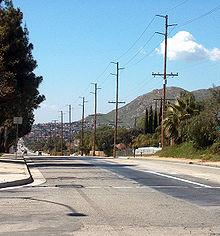
Moreno Valley experienced explosive growth in the 1980s; by 1984, the valley's population was 49,702 (contrasted with 18,871 residents in 1970). The state economic boom fueled the construction of new houses and businesses. This growth led to a push for incorporation. Although similar measures had failed in 1968 and 1983, a measure to form the city of Moreno Valley was approved by voters in 1984. The communities of Edgemont, Sunnymead, and Moreno were incorporated on December 3, 1984 to form the general law city of Moreno Valley. The first City Council was also elected in 1984, composed of Bob Lynn, Judith A. Nieburger, Steven Webb, J. David Horspool (first Mayor Pro Tem), and Marshall C. Scott (first Mayor). The City Seal and Motto were adopted the following year.
By 1990, Moreno Valley had exploded in population growth to become the second largest city in Riverside County with a population of over 118,000. Growth continued until about 1992.
In the 1990s, the robust Moreno Valley economy deteriorated, largely due to the statewide economic downturn. Many people began to leave the city. March was also downsized to its present status as March Air Reserve Base. The surplus land was given to the March Joint Powers Authority, made up of representatives of Riverside County and the cities of Riverside, Moreno Valley, and Perris for development. The dismal economic trend began to reverse in the late part of the decade, however. Companies such as Aurora Modular, U-Haul, and Lowe's moved major operating facilities to the city or neighboring municipalities (although Aurora later filed for bankruptcy).
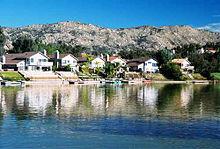
By the early 21st century, the arrival of so many newcomers to Riverside County and the soaring cost of living in Los Angeles and Orange County combined to make the less-developed southern half of the Inland Empire a very attractive place for industry.
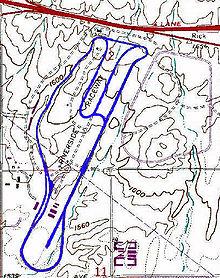
Nevertheless, Moreno Valley's coming of age can also be seen in the growth of the area around the Moreno Valley Mall (former location of the Riverside Raceway from 1957 to 1989) and nearby Day Street, which straddles the border between Moreno Valley and Riverside. The area has seen massive construction in recent years, attracting Lowe's, Starbucks, Outback Steakhouse, and other stores often seen as prestigious. A Pat & Oscar's and PFF Bank & Trust are being built, and rumors of Famous Dave's and Barnes & Noble coming to the area have emerged lately. These establishments are often seen as appealing to the upper-middle class; this appeal may help attract attention and money to the city.
On the east end of the city off Moreno Beach Drive, a new Wal-Mart was opened in early 2006 (233,000 sq ft (21,600 m2), huge for a traditional Wal-Mart) next to the Moreno Valley Auto Mall. This is also the site of the first Super Target in California and the first (and only) Best Buy store located within Moreno Valley city limits, which opened in July and October 2007, respectively. The exit off state route 60 is the main way to the Moreno Valley Ranch Golf Course, once included in Golf Magazine's Top 75 Golf Courses in the USA.
Recent proposals to turn March Joint Air Reserve Base to a major commercial airport has been debated in 2005, but the plan was rejected by the Riverside county board of supervisors, until further notice. However, the coming of quieter, more environmentally friendly aircraft and cheaper security procedures and utilities may signal a re-consideration of the plan. In May 2008 the March JPA approved opening the facility to general aircraft.
March Air Reserve base has a ball park facility, where the semi-pro baseball Inland Empire (now Rancho Belago) Rockets of the Southern California League play in the summer months season.
While some may view DHL's selection of March Air Reserve Base as its new Southern California hub as a "bright spot", the March JPA and March Global Port operations that brought DHL have been a matter of considerable controversy. DHL selected the March airport over San Bernardino International Airport and LA/Ontario International Airport. The DHL facility commenced operations in October 2005 (previously expected to be running by March 2005). While initial claims were that the facility would employ 250 workers in its initial stage, over 300 employees went to work daily during normal operations.
Neighboring residents filed an unsuccessful lawsuit to block the zoning change necessary to allow DHL's operations.
In November 2008, due to escalating financial losses associated with deteriorating macroeconomic conditions, DHL announced it was leaving the U.S. market and would shut its operation associated with March Air Field in January 2009.
On February 13, 2007, the City Council passed, by a vote of 4-1, a controversial resolution christening the eastern half of the city (roughly from Lasselle Street to Gilman Springs Road) "Rancho Belago", a pastiche of Spanish and Italian words. The city council's resolution includes the 92555 zipcode within the boundaries of the area, as reported by the Press Enterprise newspaper.
Today, Moreno Valley is home to over 200,000 residents and once again, experienced an economic bust (the Late 2000s Recession) to restart again in a new development boom. MetroLink rail transit has arrived in the area further down in Perris to the south and a proposal to erect a four-lane freeway in what is Cajalco Road/Ramona Expressway from Interstate 215 to Interstate 15 in Corona is currently debated in the CalTrans, Riverside County and Orange County governments. Upper-middle class residents in newer housing developments on the eastern half of the city. And the rise of corporate office building industrial and business parks, as well a proposal of bringing minor league baseball of the California League. Moreno Valley is rapidly becoming a Latino majority city (over 50+ percent) and now has a higher percentage of African-Americans, soon to surpass that of Compton and South Los Angeles.
Moreno Valley is located at 33 °55'35" North, 117 °13'42" West (33.926267, -117.228345).
According to the United States Census Bureau, the city has a total area of 51.5 square miles (133 km2), of which, 51.3 square miles (133 km2) of it is land and 0.2 square miles (0.52 km2) of it is water.
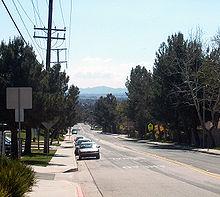
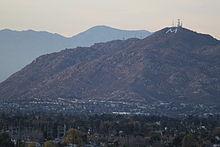
Moreno Valley is located at a geographic crossroad. To the east lie the San Gorgonio Pass and Coachella Valley; to the south are Lake Perris, Perris, the San Jacinto Mountains, and the route to San Diego; to the north are the San Bernardino Valley and San Bernardino Mountains. To the west lies neighboring Riverside, as well as Los Angeles and Orange Counties. The heavily-traveled routes of State Route 60 (locally called the Moreno Valley Freeway) and Interstate 215 both pass through the city. It lies under approach paths for Los Angeles International Airport, John Wayne Airport in Orange County, LA/Ontario International Airport and San Bernardino International Airport.
One of the most visible geographical features in Moreno Valley, visible from almost anywhere in the city, is Box Springs Mountain. This mountain at the northwest end of the city towers over the city, providing a concrete landmark. The face of the mountain that faces the city has a large "M" constructed upon it. This was built privately at the encouragement of the City Council, which argued it would foster unity. The letter is located on public land and is maintained entirely by charity. The letter had lights installed on December 3, 2005 to celebrate Moreno Valley's 21st anniversary of its incorporation and the completion of the repairs of heavy damage to the M, due to excessive rain the year before. The mayor at that time, Bonnie Flickinger, has said that the citizens liked it that way and that the council would try to get it to light up regularly. Between December 2, 2009 and December 6, 2009, Moreno Valley, along with Edison lit up the "M" in celebration of the city's 25th anniversary. Several Eagle Scout projects have been dedicated to maintaining the letter.
Moreno Valley has a mild mediterranean climate (Koppen climate classification CSa). The summer temperatures average in the mid to high 90's, though many days can reach well above 100 °.
The 2010 United States Census reported that Moreno Valley had a population of 193,365. The population density was 3,756.5 people per square mile (1,450.4/km ²). The racial makeup of Moreno Valley was 80,969 (41.9%) White, 34,889 (18.0%) African American, 1,721 (0.9%) Native American, 11,867 (6.1%) Asian, 1,117 (0.6%) Pacific Islander, 51,741 (26.8%) from other races, and 11,061 (5.7%) from two or more races. Hispanic or Latino of any race were 105,169 persons (54.4%).
The Census reported that 192,811 people (99.7% of the population) lived in households, 471 (0.2%) lived in non-institutionalized group quarters, and 83 (0%) were institutionalized.
There were 51,592 households, out of which 28,586 (55.4%) had children under the age of 18 living in them, 29,000 (56.2%) were opposite-sex married couples living together, 9,990 (19.4%) had a female householder with no husband present, 4,191 (8.1%) had a male householder with no wife present. There were 3,627 (7.0%) unmarried opposite-sex partnerships, and 375 (0.7%) same-sex married couples or partnerships. 6,094 households (11.8%) were made up of individuals and 1,611 (3.1%) had someone living alone who was 65 years of age or older. The average household size was 3.74. There were 43,181 families (83.7% of all households); the average family size was 3.99.
The population was spread out with 62,496 people (32.3%) under the age of 18, 23,563 people (12.2%) aged 18 to 24, 53,726 people (27.8%) aged 25 to 44, 41,446 people (21.4%) aged 45 to 64, and 12,134 people (6.3%) who were 65 years of age or older. The median age was 28.6 years. For every 100 females there were 95.1 males. For every 100 females age 18 and over, there were 91.3 males.
There were 55,559 housing units at an average density of 1,079.3 per square mile (416.7/km ²), of which 33,393 (64.7%) were owner-occupied, and 18,199 (35.3%) were occupied by renters. The homeowner vacancy rate was 3.4%; the rental vacancy rate was 7.5%. 123,863 people (64.1% of the population) lived in owner-occupied housing units and 68,948 people (35.7%) lived in rental housing units.
The city became a diverse ethnoburb of a variety of racial and ethnic groups, esp. Blacks, Latinos and Asians replaced the once majority White (non-Hispanic) population in the 1990s. Immigrants often come from Central America, Southeast Asia and the Philippines, the Middle East and Somalia, the Balkans, the Caribbean islands (esp. Cubans and Puerto Ricans) and Samoans to reestablish themselves in older post-WWII suburban tracts in Sunnymead.
Moreno Valley has increasingly become a destination for African-American families from Los Angeles County. Between 2006-2007 alone, Moreno Valley saw a 13% increase in its black population.
Also in the same time period, Latinos became the majority of over half the MoVal's population, especially a large Mexican-American and Mexican population developed in Sunnymead. There are several business strips catering to Spanish-speaking clientele and Latin American cultures.
There were 43,381 households out of which 54.0% had children under the age of 18 living with them, 61.6% were married couples living together, 17.1% had a female householder with no husband present, and 14.9% were non-families. 11.0% of all households were made up of individuals and 3.1% had someone living alone who was 65 years of age or older. The average household size was 3.6 and the average family size was 3.9.
In the city the population was spread out with 36.8% under the age of 18, 10.5% from 18 to 24, 29.5% from 25 to 44, 17.7% from 45 to 64, and 5.5% who were 65 years of age or older. The median age was 27 years. For every 100 females there were 95.8 males. For every 100 females age 18 and over, there were 91.3 males.
The median income for a household in the city was $47,387, and the median income for a family was $48,965 (these figures had risen to $55,604 and $57,385 respectively as of a 2007 estimate). Males had a median income of $38,620 versus $26,492 for females. The per capita income for the city was $14,983. 14.2% of the population and 11.6% of families were below the poverty line. 18.1% of those under the age of 18 and 9.7% of those 65 and older were living below the poverty line.
Moreno Valley is an incorporated common law city. It is governed by a council-manager government. The city is divided into five districts, each of which elect a representative. The council chooses two of its own members to serve as Mayor and Mayor Pro Tem. The council also selects the city manager. The current City Council consists of:
Richard Stewart is the current Mayor. Jesse Molina is the current Mayor Pro Tem. The current City Manager is Henry Garcia.
According to the city aos most recent Comprehensive Annual Financial Report, the city aos various funds had $243.3 million in Revenues, $132.8 million in expenditures, $1,076.3 million in total assets, $195.3 million in total liabilities, and $293.8 million in cash and investments.
The structure of the management and coordination of city services is:
In the state legislature Moreno Valley is located in the 37th Senate District, represented by Republican Bill Emmerson, and in the 63rd, 64th, and 65th Assembly Districts, represented by Republicans Mike Morrell, Brian Nestande, and Paul Cook respectively. Federally, Moreno Valley is located in California's 45th congressional district, which has a Cook PVI of R +3 and is represented by Republican Mary Bono Mack.
Moreno Valley is serviced by its own regional station of the Riverside County Sheriff's Department for law enforcement. The sheriff's station is currently commanded by Captain John Anderson, who also functions as Moreno Valley's Chief of Police.
Moreno Valley also contracts for fire services with the Riverside County Fire Department through a cooperative agreement with Cal Fire (California Department of Forestry and Fire Protection). Six paramedic engines and two truck companies provide both fire and paramedic services to the city.
American Medical Response is responsible for transports to emergency departments via paramedic ambulance.
Moreno Valley's primary and secondary education needs are fulfilled by the Moreno Valley Unified School District and the Val Verde Unified School District. The former serves approximately 35,000 students, the bulk of the city's children, and has 35 schools, including five high schools: Moreno Valley High School, Canyon Springs High School, Valley View High School, March Mountain High School, and Vista del Lago High School. Val Verde District serves part of southern and eastern Moreno Valley, in addition to parts of Perris, Mead Valley, and unincorporated areas. It serves about 13,000 students and maintains 12 schools; one of its high schools, Rancho Verde High School, is located in Moreno Valley. Some private schools exist, including the local Valley Christian Academy, established in 1979, and Calvary Chapel Christian School, which serves students Kindergarten to twelfth grade.
The Riverside Community College District, RCCD, serves 6,500 students at their Moreno Valley College campus. The city is also the location of one of the twenty-six Chapman University campuses. In Neighboring Riverside, students may opt to attend RCCD's main campus, Riverside Community College, the University of California, Riverside, La Sierra University or California Baptist University. California State University, San Bernardino is another popular school for city high school graduates.
According to the City's 2009 Comprehensive Annual Financial Report, the top employers in the city are:
There are two hospitals in Moreno Valley:
Word Count: 4166






